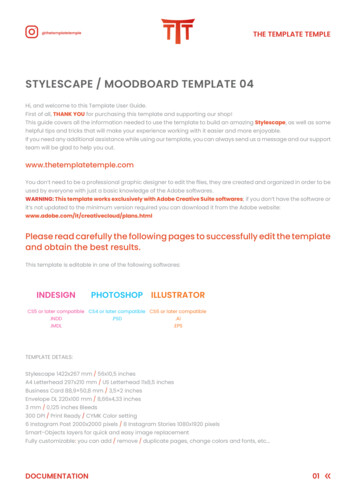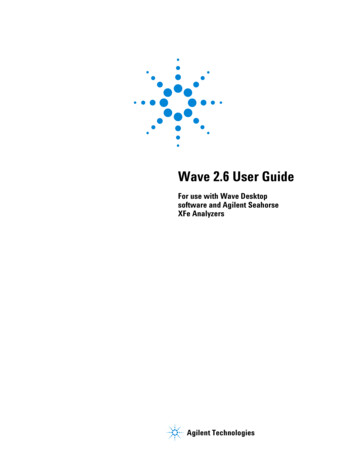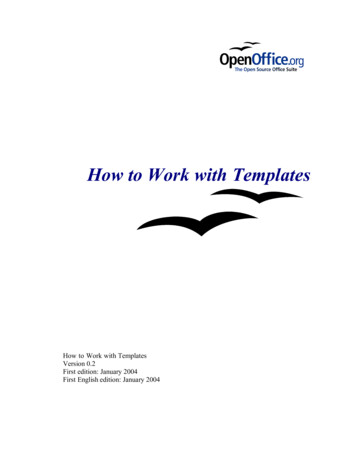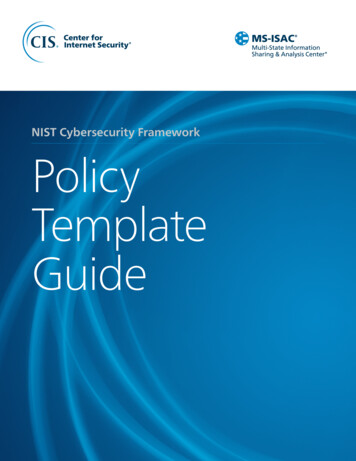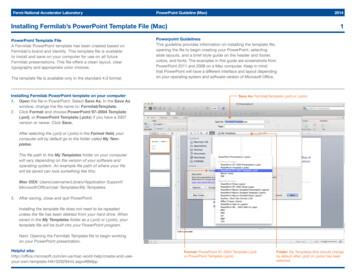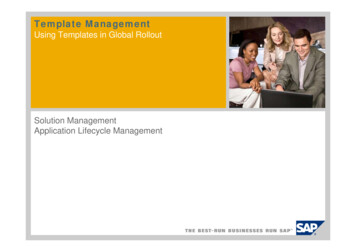
Transcription
HEALTHANDSAFETYPOLICYTEMPLATE
Health and Safety at Work Act, 1975Statement of (add group name)Health and Safety PolicyPolicy agreed on .Please note that this is a comprehensive policy. Some areas ofthe policy will not be required for your group/organisation,therefore, please only use the sections that are relevant to yourgroup/organisation.For information about health and safety ring HSE’s Infoline Tel: 0845 345 0055 Fax: 0845408 9566 Textphone: 0845 408 9577 email: hse.infoline@natbrit.com or write to HSEInformation Services, Caerphilly Business Park, Caerphilly CF83 3GG.
PART ONEGeneral Statement of Policy, Duties & Responsibilities1.1Policy StatementThe(state name of group) recognises and accepts its health and safety duties forproviding a safe and healthy working environment (as far as is reasonably practicable) for allits workers (paid or volunteer) and other visitors to its premises under the Health and Safetyat Work Act 1974, the Fire Precautions (Workplace) Regulations 1997, the Management ofHealth and Safety at Work Regulations 1999, other relevant legislation and common lawduties of care.Throughout this Statement, terms such as “staff”, “workers”, “employees”, include both paidand volunteer workers.It is the policy of the Group/Organisation to promote the health and safety of the committeemembers, volunteers, staff and of all visitors to the Groups/Organisation’s premises (“thePremises”) and to that intent to: Take all reasonably practicable steps to safeguard the health, safety and welfare ofall personnel on the premises; Provide adequate working conditions with proper facilities to safeguard the healthand safety of personnel and to ensure that any work which is undertaken producesno unnecessary risk to health or safety; Encourage persons on the premises to co-operate with the Organisation in all safetymatter, in the identification of hazards which may exist and in the reporting of anycondition which may appear dangerous or unsatisfactory; Ensure the provision and maintenance of plant, equipment and systems of work thatare safe; Maintain safe arrangements for the use, handling, storage and transport of articlesand substances; Provide sufficient information, instruction, training and supervision to enableeveryone to avoid hazards and contribute to their own safety and health; Provide specific information, instruction, training and supervision to personnel whohave particular health and safety responsibilities (eg a person appointed as a Healthand Safety Officer or Representative); Make, as reasonably practicable, safe arrangements for protection against any risk tohealth and safety of the general public or other persons that may arise for theGroups/Organisation’s activities; Make suitable and sufficient assessment of the risks to the health and safety ofemployees and of persons not in the employment of the Groups/Organisation arisingout of or in connection with the Groups/Organisation’s activities; Make specific assessment of risks in respect of new or expectant mothers and youngpeople under the age of eighteen; Provide information to other employers of any risks to which those employer’sworkers on the Groups/Organisation’s premises may be exposed.This policy statement and/or the procedures for its implementation may be altered at anytime by the Groups/Organisation’s Management Committee (“the Committee”). Thestatement and the procedures are to be reviewed in the (autumn) of each year by the Healthand Safety Sub-committee or by other persons appointed by the Committee. A report on thereview, with any other proposals for amendment to the statement of procedures, is to bemade to the next following ordinary meeting of the Management Committee.
1.2Statutory Duty of the Group/OrganisationThe Group/Organisation will comply with its duty to ensure, as far as is reasonablypracticable, the health, safety and welfare at work of its workers and of visitors to itspremises and, in general, to: Make workplaces safe and without risks to health; Ensure plant and machinery are safe and that safe systems of work are set andfollowed; Ensure articles and substances are moved, stored and used safely; Give volunteers/ workers the information, instruction, training and supervisionnecessary for their health and safety.In particular, the Group/Organisation will: Assess the risks to health and safety of its volunteers/workers; Make arrangements for implementing the health and safety measures identified asnecessary by this assessment; Record the significant findings of the risk assessment and the arrangements forhealth and safety measures; Draw up a health and safety policy statement; including the health and safetyorganisation and arrangements in force, and bring it to the attention of its workers; Appoint someone competent to assist with health and safety responsibilities; Set up emergency procedures; Provide adequate First Aid facilities; Make sure that the workplace satisfies health, safety and welfare requirements, egfor ventilation, temperature, lighting and for sanitary, washing and rest facilities; Make sure that work equipment is suitable for its intended use as far as health andsafety is concerned, and that it is properly maintained and used; Prevent or adequately control exposure to substances that may damage health; Take precautions against danger form flammable or explosive hazards, electricalequipment, noise or radiation; Avoid hazardous manual handling operations and, where they cannot be avoided,reduce the risk of injury; Provide health surveillance as appropriate; Provide free any protective clothing or equipment, where risks are not adequatelycontrolled by other means; Ensure that appropriate safety signs are provided and maintained; Report certain injuries, diseases and dangerous occurrences to the appropriatehealth and safety enforcing authority.1.3Statutory Duty of the Groups/Organisation’s WorkersEmployees also have legal duties, and the Organisation confidently requests non-employed(voluntary) workers also to observe these. They include the following: To take reasonable care for their own health and safety, and that of other personswho may be affected by what they do or do not do; To co-operate with the Group/Organisation on health and safety; To use work items provided by the Group/Organisation correctly, including personalprotective equipment, in accordance with training or instructions; Not to interfere with or misuse anything provided for health, safety and welfarepurposes;
To report at the earliest opportunity injuries, accidents or dangerous occurrences atwork, including those involving the public and participants in activities organised bythe Group/Organisation;Health and Safety law applies not only to employees in the workplace, it also appliesto organisations and people who occupy or use community buildings to whichmembers of the public have access.1.4Policy for Visitors and ContractorsOn arrival all visitors should be directed to the duty representative of the ManagementCommittee, or a representative of the user/hirer of the building. This person is to takeresponsibility for the visitor(s) and assist in their evacuation from the building during anemergency or arrange help in the event of an accident.On arrival, all visitors, including contractors and/or their workers, must sign a record of thedate and time of their arrival and, before leaving, should further record their time ofdeparture.Contractors working in the building should report any concerns relating to their own safety orsuspected unsafe working practices to the Duty representative of the Committee who willinvestigate and report to the Group/Organisation.
PART TWOOrganisation of Health and Safety2.1Health and Safety Sub-committeeThe Management Committee will appoint a Health and Safety Sub-committee, includingrepresentation both of themselves and of staff (both paid and volunteer): To have a broad overview of Health and Safety matters; To keep the Organisation’s Health and Safety policy and procedures under review; To conduct safety tours of the premises; To ensure that risk assessments are carried out, including assessments regardingsubstances hazardous to health (COSSH Regulations); To take such action as may be required to ensure that the Organisation’sresponsibilities for Health and Safety are fulfilled; To report to the Management Committee on their performance of theseresponsibilities.Contractors working in the building should report any concerns relating to their own safety orsuspected unsafe working practices to the Duty representative of the Committee who willinvestigate and report to the Organisation.Safety ToursThe Health and Safety Committee shall carry out 6-monthly tours and inspections of thepremises and make a report to the next ordinary meeting of the Management Committee.All necessary actions as a result of the tour shall, where reasonable and practicable, beimplemented. The tour shall include inspection of the Accident File.2.2Health and Safety RulesAll workers must exercise ordinary care to avoid accidents in their activities at work andcomply with the following general rules and with any further rules which theGroup/Organisation may publish from time to time.Accident Forms and BookThe book must be kept in a locked drawer once completed.Any injury suffered by a worker or visitor in the course of employment or otherwise on theGroups/Organisation’s premises, however slight, must be recorded, together with such otherparticulars as are required by statutory regulations, on an accident form maintained by theOrganisation.Fire PrecautionsAll personnel must familiarise themselves with fire escape routes and procedures and followthe directions of the Group/Organisation in relation to fire.Equipment and AppliancesNo equipment or appliance may be used other than as provided by or specifically authorisedby or on behalf of the Group/ Organisation and any directions for the use of such must befollowed precisely.
Safety ClearwaysCorridors and doorways must be kept free of obstructions and properly lit.MaintenanceDefective equipment, furniture and structures must be reported as such without delay.Hygiene and Waste DisposalFacilities for the disposal of waste materials must be kept in a clean and hygienic condition.Waste must be disposed of in an appropriate manner and in accordance with any specialinstructions relating to the material concerned.Food HygieneWhen handling or preparing food there are specific hygiene requirements: Regularly wash hands before and during food preparation and especially after usingthe lavatory; Tell your supervisor or representative of the Committee of any skin, nose, throat, orbowel problem; Ensure cuts or sores are covered with correct waterproof dressings; Keep yourself clean and wear clean clothing; Remember that smoking in a food room is illegal; Never cough or sneeze over food; Clean as you go. Keep all equipment and surfaces clean; Prepare raw and cooked food in separate areas. Keep perishable food covered andeither refrigerated (less than 8”C) or piping hot (above 63”C); Ensure waste food is disposed of properly. Keep the lid on rubbish bin and washyour hands after putting waste in it; Avoid handling food as far as possible; Tell your supervisor or representative of the Committee of any defects or concernsregarding the facilities – eg uncleanness, refrigeration malfunction, cracked foodpreparation surfaces.Display Screen EquipmentThe Group/Organisation recognises its responsibility to ensure the well-being of workerswho habitually use display screen equipment for a significant part of their normal work.Volunteers/Workers are advised to ensure that they take a five minute break from the displayscreen equipment at least once an hour and are advised that, if they experience visiondefects or other discomfort that they believe may be wholly or in part a consequence of theiruse of such equipment, they have the right to an eye-test at the Organisation’s expense.Alcohol, Drugs and TobaccoSmoking within the premises and the use of Drugs (except under medical supervision) onthe premises are prohibited at all times. The use of intoxicants (alcohol) is prohibited duringworking hours, and no employee/volunteer may undertake his/her duties if under theinfluence of alcohol or drugs (except under medical supervision)
PART THREEArrangement and ProceduresThe Health and Safety Officer, nominated by the Management Committee, is responsible forensuring that the safety policy is carried out and that responsibilities for safety, health andwelfare are properly assigned and accepted at all levels. His/her details and contact numberwill be displayed 3.13.2First Aid and Accident ReportingFire Drills and Evacuation Procedures3.1.1 First Aid The current First Aider(s) for the premises is/are displayed (on the NoticeBoard in the Reception Area). First Aid Boxes are provided in the following location(s):i)Reception (example)ii)Kitchen (example)3.1.2 3.3AccidentsIn the event of an injury or illness, call for a member of staff or ring for anambulance directly. To call an ambulance – dial 999 and ask for“ambulance”;All accidents must be reported to the Health and Safety Officer or anothermember of staff on duty immediately or as soon as practicable;All accidents must be entered on an accident form, available from thereception desk. The procedures for “notifiable” accidents as shown inAppendix A below must be followed;The Health and Safety Officer will investigate incidents and accidents, writinga detailed report for the Organisation’s Management Committee to considerthe actions necessary to prevent recurrence.Fire Drills and Evacuation Procedures3.2.1 Fire Drills All workers and volunteers must know the fire procedures, position of fireappliances and escape routes. The fire alarm points, fire exits and emergency lighting system will be testedby The Fire Officer/Health and Safety Officer during the first week of eachmonth and entered in the log book provided. The Fire Officer will arrange for Fire Drills and Fire Prevention Checks (seeAppendix C below) to be carried out at least once every three months andentered in the log book. In addition, these Drills will be carried out at differenttimes and on different days, so that all users/hirers know the procedures. The last person securing the premises will ensure Fire Prevention CloseDown Checks are made of all parts of the premises at the end of a session(See Appendix C).3.2.2 in the event of FirePersons discovering a fire should sound the nearest alarm;The first duty of all workers is to evacuate all people from the building by thenearest exit immediately the fire is discovered;
3.2.3 All persons must evacuate the building and, where possible without personalrisk, leave all doors and windows closed;The assembly point for the building is at the No-one should leave the assembly point without the permission of a memberof staff;If any fire occurs, however minor, the Fire Brigade must be calledimmediately by dialling 999 and asking for “Fire”;When the Fire Brigade arrives advise whether all persons are accounted forand location of fire.Bomb WarningsIf you receive a warning try to find out from the caller:i)The approximate location of the bomb and likely time of detonation;ii)Whether the police and fire brigade have been notified;iii)Try to RECORD EXACTLY WHAT IS SAID:Notify the Police immediately on 999;DO NOT SOUND THE FIRE ALARM but evacuate the building taking intoconsideration any information form the bomb warning;Assemble in the unless the bomb warning impliesotherwise.3.2.4 Theatre – and Public Entertainment – Licensed EventsIn addition to the general conditions of the licence(s): Hirers/users must be aware of the Health and Safety Policy; Emergency lights in the areas used must be kept illuminated; Advise the representative of the Management Committee of any defects orconcerns regarding the facilities, eg uncleanness, refrigeration operation,cracked food preparation surfaces.3.2.5 Cleaning Materials, General Machinery and High Risk AreasAll portable machinery must be switched off and unplugged when not in use;Wandering cables are a hazard; use with caution and safety in mind;Slippery floors and dangerous; use warning signs;Use protective clothing and equipment provided and as instructed onmachinery/equipment/material. It is the duty of a worker to report any loss ofor defect in protective clothing or equipment.3.2.6 GeneralAll thoroughfares, exits and gates must be left clear at all times;Corridors and fire exits must not be blocked by furniture or equipment;Vehicles must not be parked near to the building so as to cause anyobstruction or hazard;Hazards or suspected hazards or other health and safety matters should bereported to the Health and Safety Officer or the staff member on dutyimmediately or as soon as practicable, so that action can be taken. If thehazard is of a serious nature, immediate action must be taken to protect orclear the area to prevent injury to staff or other users.
PART FOURAppendicesAPPENDIX A – ACCIDENT REPORTING1. AccidentsAll accidents which occur during work for the Group/Organisation and/or for the User/Hirer,or on premises under the control of the Group/Organisation must be recorded.2. Accidents to Workers or Contractor’s Staffa) For ALL AccidentsComplete Accident Form and give to Health & Safety Officerb) For accidents reportable to the Health & Safety Executive (for contractorssee c))If accident results in incapacity for work for more than 3 calendar days thencomplete the online form F2508 with copies to the Chair of the ManagementCommittee.If accident results in fatality, fracture, amputation or other specified injury (seesection 4, below) then immediately notify:Health & Safety Executive on HSE’s Infoline Tel: 0845 345 0055And the Chair of the Management CommitteeFollow up within seven days with completed online form F2508 with copies tothe Chair of the Management Committeec) If a reportable accident involves a contractor’s employee and the premises areunder the control of someone other than the contractor then the person in controlof the premises is responsible for reporting the accident.If a contractor’s employee is at work on premises under the control of thecontractor then it is the contractor or someone acting on his/her behalf who isresponsible for reporting the accident.3. Accidents to Members of the Public1. For ALL AccidentsComplete Accident Form and give to Health & Safety Officer2. For accidents reportable to the Health & Safety ExecutiveIf an accident results in fatality, fracture, amputation or other specified injury (seesection 4 below) then immediately notify:Health & Safety Executive, Incident Contact Centre, Caerphilly BusinessPark, Caerphilly, CF83 3GGAnd the Chair of the Management Committee
Some injuries may not be fully identified until the casualty has been to hospital. Itis therefore essential that, if it is known that an individual has gone to hospital asa result of an accident, follow up action is carried out.4. Definition of Specified Major Injuries or Conditions Fracture of the skull, spine or pelvis; any bone in the arm or wrist, but not a bonein the hand; any bone in the leg or ankles, but not a bone in the foot. Amputation of; a hand or foot, a finger, thumb or toe; any part thereof if the jointor bone is completely severed Other specified injuries and conditions:o The loss of sight of an eye; a penetrating injury to the eye, or a chemicalor hot metal burn to an eyeo Injury (including burns) either requiring immediate medical treatment, orinvolving loss of consciousness, resulting (in either case) from electricshock from any electrical circuit or equipment, whether or not due to directcontacto Loss of consciousness resulting from lack of oxygeno Decompression sickness requiring medical treatmento Either acute illness requiring treatment, or loss of consciousness,resulting (in either case) from absorption of any substance by inhalation,ingestion or through the skino Acute illness requiring medical treatment where there is reason to believethat this resulted from exposure to a pathogen or infected materialo Any other injury which results in the person injured being admittedimmediately into hospital for more than 24 hoursIF IN DOUBT REPORT IT5. Dangerous OccurrencesIn the event of any of the following: Collapse/Overturning of machinery Explosion/collapse of closed vessel/boiler Electrical explosion/fireNotify the following immediately:Health & Safety Executive, Incident Contact Centre, Caerphilly BusinessPark, Caerphilly, CF83 3GG HSE’s Infoline Tel: 0845 345 0055email: hse.infoline@natbrit.comAnd the Chair of the Management Committee6. Occupational DiseasesooooPoisoningSkim DiseasesLung DiseasesInfections
On receipt of a written diagnosis from a Doctor, report the disease usingonline form F2508A to: hse.infoline@natbrit.comAnd the Chair of the Management CommitteeFull details of Dangerous Occurrences and Occupational Diseases can be found in HSERIDDOR Booklets 11 and 17.IF IN DOUBT REPORT ITAppendix B – CONTROL OF SUBSTANCES HAZARDOUS TO HEALTH (COSHHREGULATIONS)1. AssessmentThe assessment must be a systematic reviewo What substances are present and in what form?o What harmful effects are possible?o Where and how are the substances actually used or handled?o What harmful effects are given off, etc.?o Who could be affected, to what extent and for how long?o Under what circumstances?o How likely is it that exposure will happen?o What precautions need to be taken to comply with the COSHH Regulations?o What procedures need to be put in place to comply with the Control of Asbestosat Work Regulations 2002?2. Prevention or ControlEmployers have to ensure that the exposure of workers to hazardous substances isPREVENTED or, if this is not reasonably practicable ADEQUATELY CONTROLLED.On the basis of the assessment, the employer has to decide which control measures areappropriate to the work situation in order to deal effectively with any hazardoussubstances that my present. This may mean PREVENTING exposure byo Removing the hazardous substance by changing the processo Substituting with a safe or safer substance, or using a safer formOr, here this is not reasonably practicable, CONTROLLING exposure byo Totally enclosing the processo Using partial enclosure and extraction equipmento General ventilationo Using safe systems of work and handling proceduresIt is for the employer to choose the method of controlling the exposure and to examineand test control measures, if required.The Regulations limit the use of Personal Protective Equipment (e.g. dust masks,respirators, protective clothing) as the means of protection of those situations ONLYwhere other measures cannot adequately control exposure.
Employers must provide any of their workers and, so far is reasonably practicable, otherpersons on site who may be exposed to substances hazardous to health, with suitableand sufficient information, instruction and training to that they know the risks they runand the precautions they must take.Employers must ensure that anyone who carries out any task in connection with theirduties under COSHH has sufficient information, instruction and training to to the jobproperly.Appendix C – FIRE PREVENTION1. Has the Fire brigade been consulted on:o The number and width of escape routes so as to provide a ready means ofescape from all parts of the premises?o Emergency lighting and its maintenance?o The most suitable way of raising an alarm in the event of fire?o The contents of fire instruction notices?o The numbers and types of fire extinguishers or other fire-fighting applianceswhich should be provided?o Precautions to be taken with any activities involving the use of flammableliquids, naked flames or heating processes?o The desirability of battening or clipping seats together in sets of four wheremoveable seats are used for large audiences?o The maximum number of people who should be allowed on the premises atany one time?o Are seating and gangways in the hall/rooms so arranged as to allow free andeasy access direct to fire exits?o Are exit doors always unlocked before the start of any session and keptunlocked until the last person leaves?o Are escape routes and exit doors clearly sign-posted and marked so thatanyone not familiar with the building can quickly see the ways out?o Are escape routes and exit doors never allowed to become obstructed orhidden by chairs, stage props, curtains etc.?2. Is Fire Equipment properly looked after?o Are fire extinguishers, hose reels and fire alarm systems (where provided)regularly maintained by specialist fire engineering firms?o Are staff/duty officers trained to use this equipment?o Is equipment kept in its proper position and always clearly visible andunobstructed?3. Are thorough close-down checks made of all parts of the premises at the end of anevening or session?o No smouldering fires or cigarettes left burning?o Heater and cookers turned off?o Televisions and other electrical apparatus turned off and unplugged?o Lights off?o Internal doors closed?o Outside doors and windows closed and secured?
4. Are all reasonable steps taken to prevent fires?o Smoking not allowed in store rooms or backstage?o Substantial ashtrays provided in areas where smoking is permitted?o Heating appliances fitted with adequate and secure fire guards?o If portable heaters have to be used, are they securely fixed and kept awayfrom combustible materials?o Precautions to ensure that convector type heaters are not covered withclothes and curtains?o Temporary extensions or additions to the electrical installation carried out andchecked by a competent electrician?o Sufficient socket outlets provided to obviate the need for long trailing flexes?o Damaged leads replaced regularly?o Cooking operations supervised by a reliable person?o Scenery, decorations and costumes for stage performances treated to makethem flame retardant?o All parts of the premises kept clear of waste and rubbish, particularlystaircases, space under stairs, store rooms, attics and boiler rooms?Appendix D – HEALTH AND SAFETY INSPECTION1. Inspectiono A Health and Safety inspection of the building should be undertaken at leastevery six months. One of these inspections may be undertaken at the sametime as the annual building maintenance check.o Appointed members of the Management Committee, or a sub-group, shouldarrange to meet and carry out the inspectiono This inspection group will need to agree how each question needs to beansweredo When the form is complete and has been signed, matters noted as notsatisfactory, together with any other concerns raised by the inspection, shouldbe reported to the Management Committee.o The inspection group should be authorised, where URGENT action isnecessary, to make immediate reasonable responseo The whole form should be made available to members of the ManagementCommitteeo The forms should be preserved in a file maintained for this purpose. Asrequired action is taken, the responsible person should initial the form in theappropriate box2. Risk Assessmento Risk assessments relate to activities within the premises or groundso Risk assessments NEED to be carried out in relation to every activityundertaken, whether by groups or individuals and including the work of paidstaff AND volunteerso Special attention should be paid to the circumstances of workers under theage of eighteen and to expectant mothers, women who have given birthwithin the past six months or who are breastfeedingo A risk assessment needs to be carried out whenever a new activity isenvisagedo Assessments need to be repeated whenever circumstances change:
Changes in layout of equipmentObserving trends on the accident formChanges in staffIntroduction of new procedures, processes or materialsAppendix E – DISPLAY SCREEN EQUIPMENT1. Who is a Display Screen User?The regulations are for the protections of workers (including self-employed workersand volunteers) who habitually use display screen equipment for a significant partof their normal work.In some cases it will be clear that the use of Display Screen Equipment is more orless continuous on most days and the individual concerned should be regarded asusers. Where use is less continuous, ‘user’ status would apply if most or all of thefollowing criteria are met:o The individual depends on the use of display screen equipment to do the job,as alternative means are not readily available for achieving the same results.o The individual has no discretion as to the use or non-use of the displayscreen equipmento The individual needs significant training and/or particular skills in the use ofdisplay screen equipment to do the jobo The individual uses display screen equipment in this way more or less dailyo Fast transfer of information between the user and the screen is an importantrequirement of the jobo The performance requirements of the system demand high levels of attentionand concentration by the user; for example where the consequences of errormay be critical.2. Workers’ Entitlement2.1 Eye TestAny worker covered by the Regulations is entitled to request an eye and eyesight testwhich will be paid for by the employer. Workers should inform their line manager,who will provide them with the forms to take to an option of the worker’s choice.A worker may request a test if he/she:o Is already a user for a significant part of his/her worko Is about to start using display screen equipment for a significant part ofhis/her worko Is experiencing visual difficulties which may reasonably be considered to berelated to display screen worko It is recommended by an option at the time of an eye examination that theworker should have eye tests at
PART ONE General Statement of Policy, Duties & Responsibilities 1.1 Policy Statement The (state name of group) recognises and accepts its health and safety duties for providing a safe and healthy working environment (as far as is reasonably practicable) for all

